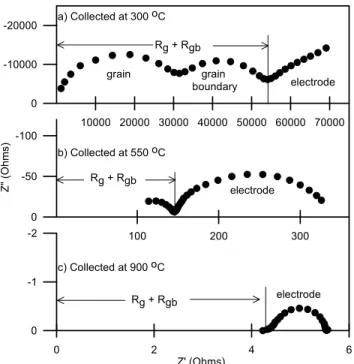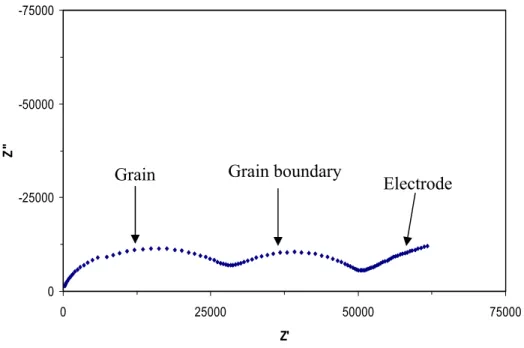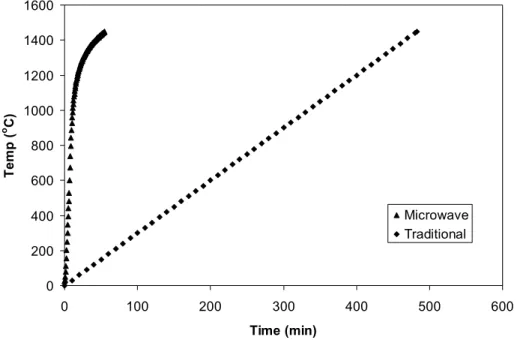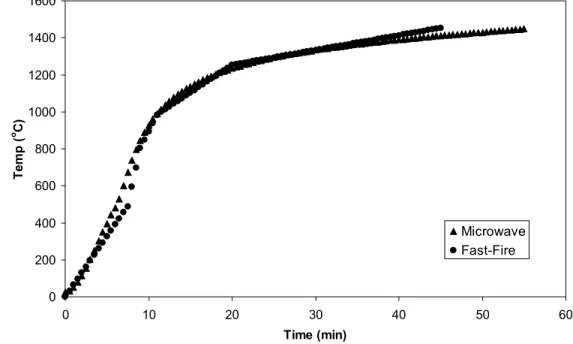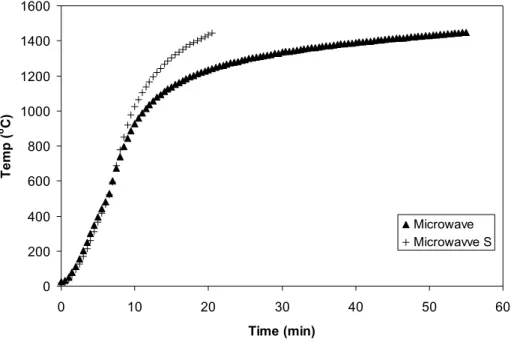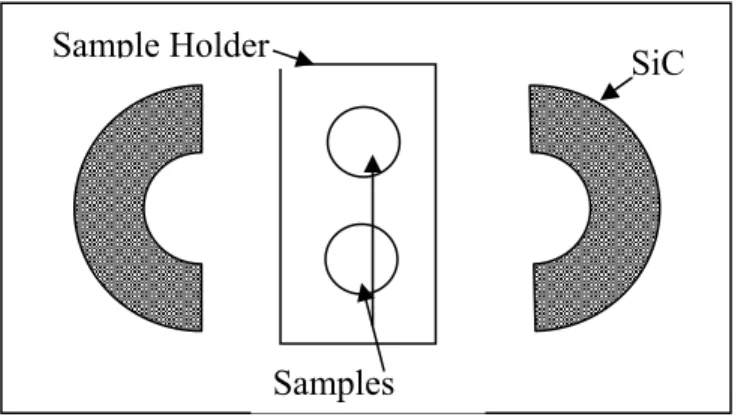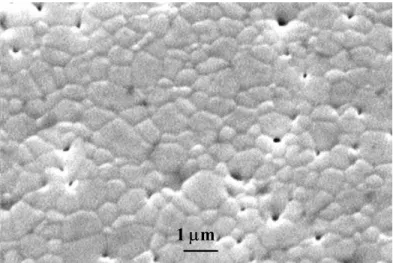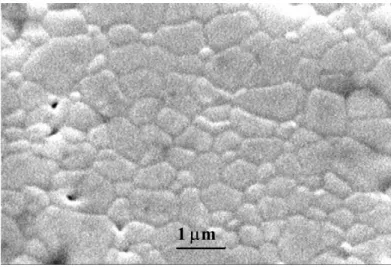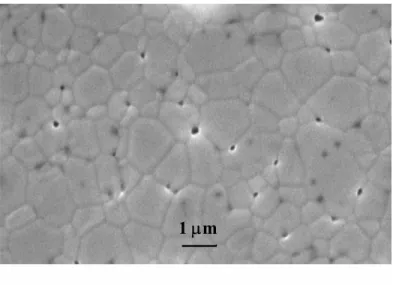A comparative study of the microstructure and electrical properties was carried out on three different sintering techniques - microwave, rapid - fire and conventional - were investigated as a means of sintering 8 mol% YSZ. By correlating the microstructure (grain size/shape and grain boundary) and high-temperature electrical properties of sintered samples, a better understanding of the microwave sintering process and how this process affects the final electrical properties of YSZ was determined. In the literature, a so-called "microwave effect" is mentioned as the cause of the observed differences in sintering rate and microstructure.
Therefore, it is interesting to determine what effect the application of microwave sintering has on the local electrical properties of 8 mol% YSZ.
Conventional Sintering
In the case of YSZ, the defects are the vacancies in the oxygen sites due to the addition of yttria. There are several diffusion pathways which include i) surface diffusion ii) grain boundary diffusion iii) lattice diffusion (both surface and bulk diffusion) and iv) vapor transport. Of all these mechanisms, only surface, grain boundary, and surface lattice diffusion lead to material densification.
Bulk lattice diffusion and vapor transport mechanisms assist in consolidation, the process of grain growth and reduction of pore and grain boundary surface area.11,12.
Microwave Sintering
Microwave – Material Interactions
As shown in Equation (4), the dielectric properties (ε”, ε”r and tan δ) play an important role in determining the extent of the power absorbed by a material. Where ρ is the density and Cp is the heat capacity of the material on a gram basis. Increasing the temperature increases the dielectric properties (ε”, ε”r and tan δ) of the material, causing portions of the material to heat up exponentially.
This part of the material can potentially melt, deform or fail.13,14 Although these problems are significant, a method of melting ceramics with low loss by hybrid heating has been developed.5,17,18.
Hybrid Heating and Sintering of 8 mol% YSZ
Due to material interactions, there are several problems associated with improper control of microwave sintering. The non-uniformity due to sample preparation causes areas of the ceramic to heat up faster than other parts, resulting in cracks due to induced stresses at the thermal boundaries. As the sintering temperatures increased, the relationship between density and microstructure of the two techniques became similar.
The heating rates of Nightingale et al.20 ranged from a constant 2oC/min to 20oC/min and a maximum of 30oC/min according to Janey et al.5 Soaking times ranged from 0 – 1 hour.
Impedance Spectroscopy
Determination of the Activation Energy
This additional temperature dependence is related to the diffusion of charged ions through the material, which is highly thermally dependent. The drift velocity, VD, is given as fnet*a, which describes the movement of ions through the material at the lattice distance. For electronic conductivity, VD = eτ/m, where e is the charge of the conducting species, m is the mass of the conducting species, and τ is the relaxation time or time between collisions.
Therefore, for ionic conduction there is an additional temperature term, which correlates with the movement of the charged ions through the material.
Impedance Work on 8 mol% YSZ
In the lower temperature regions, the oxygen vacancies formed clusters, while the oxygen vacancies were free to conduct the higher temperature regions.25 However, there are other cases (those mentioned above) where the analysis showed that there was only one conduction mechanism. for YSZ.2,3,26. The sintered pellets were characterized using scanning electron microscopy (SEM) to determine microstructure and grain size, Archemedes' method to determine density, and impedance spectroscopy to determine electrical properties at high temperatures.
Sample Sizes and Sintering Rates
Sintering Equipment
Characterization
Density
SEM / Grain Size Measurements
Impedance Spectroscopy
Microstructure
Cross-sectional micrographs were taken of the microwave and rapid-fire samples to demonstrate any effects of the volumetric heating mechanism caused by the use of microwave energy. Figures 12 and 13 show photomicrographs of the cross-sectional microstructures of the microwave and rapid-fire samples, respectively. For the microwave samples, it is noted that there is a small, but not statistically significant, variation in the average grain size across the cross-sectional area.
When the center of the sample is reached, the grains show a slight increase in average diameter. When comparing the cross-sections of the samples with the surface of the microwave-treated samples, the internal average grain size was significantly larger, giving an average size of 1.1 µm vs. Nightingale et al.2,20 have shown that there was no difference in the cross-sectional area compared to the rest of the sample, which is the opposite of what was observed.
From this observation, it is suggested that the interior of the sample was at a higher temperature than that observed on the surface. However, comparing the 1400oC dwell time samples with the samples fired at 1400oC without dwell time there is an increase in average grain size. The microwave sintered samples showed the greatest increase in grain size with increasing dwell time.
The evolution of grain size with respect to the sintering temperature (no dwell) is shown in Figure 17. The trend in the average grain size as a function of the sintering temperature is consistent with what has been observed before.2,5,20,21 What It is also of interest that the microstructures at oC of the conventional and microwave sintered samples are similar.
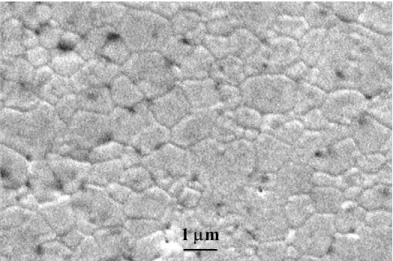
Density
Above 1450oC, density leveling occurs, which means that the maximum density of the samples prepared according to the method described in this thesis is reached. At higher sintering temperatures in Figure 18, the density of microwave sintered samples approaches that of conventionally treated samples, indicating that the microwave treatment technique can produce the same density as conventionally sintered samples, but in significantly less time. The “microwave effect”, the difference between the temperatures of microwave and conventionally sintered materials with the same microstructure, was calculated to be approximately 30 +/- 2o for this experiment.
Another cause for the differences may arise from how accurately the temperature was measured, both in this thesis as well as in the other experiments. Since microwave sintering involves a volumetric heating mechanism, the interior of the samples may be at a higher temperature than the surface of the samples. Also, introducing a shielded thermocouple can potentially cause the local area around the thermocouple to be at a higher temperature due to the microwave energy being focused by the metal.
To correct for this error, the thermocouple was raised a few millimeters to reduce the concentration of microwave energy, giving the cavity inside the microwave box a more uniform heating profile. The two different heating profiles for the microwave sintered samples and the inclusion of a residence time greatly influenced the final density of the sintered samples. The density of the samples processed with the faster heating profile was significantly lower compared to that of the samples processed with the slower microwave heating profile.
The lower density is caused by the reduced amount of time for sintering to occur for the faster heating profile. By including the residence times, the densities of the samples processed with the "microwave s" profile increased and were comparable to the densities achieved without a residence time using the.
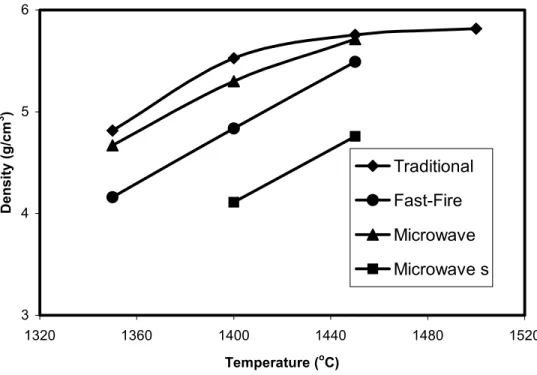
Impedance Data
1000/T and are summarized in Table II, along with the linear least squares statistics fitting the data. The only significant difference was that the conductivity of the rapid-fire samples produced at 1350oC was slightly lower than that of both the microwave samples and the conventional sintered samples. This did not happen in the microwave-treated samples because the grain size in the center of the samples was larger than the surface, thus reducing the number of grain boundaries.
The microwave and conventional sintered samples also showed similar activation energies, both less than the rapid firing samples, showing that there is no significant difference in the conduction mechanism for the conventional and microwave processed samples. However, the activation energies of the microwave residence time samples are still higher than the slower heating profile samples of the same temperature. The conventional sample showed an increase in activation energy with the addition of the residence time, which was unexpected.
The activation energy for this sample is similar to the lowest sintering temperature without the inclusion of a dwell. showed that testing the conductivity via DC four-probe method showed the microwave sintered samples showed slightly lower, but comparable, electrical activation energy when analyzed against conventional methods.3. The conductivity versus grain size relationship is similar for samples processed by all three methods, suggesting that the local electrical properties of the grain and grain boundary regions do not depend on the sintering method used. The microwave and conventionally sintered samples reported by Li et al. shows the same general relationship for ZrO2 co-doped with CaO and Y2O3.28.
However, at higher sintering temperatures, the relationship between density and grain size as a function of microwave sintering temperature and conventional processes was similar. This indicates that the microwave-treated samples can achieve similar density-grain size relationships, but the time required for the microwave samples is significantly shorter. This also implies that any of the three techniques can be used to achieve 8 mol% YSZ with desired properties, but the time required to achieve the desired microstructure will be different.
-Phase rearrangement during sintering of 8 mol% yttria-stabilized zirconia," J. Ceramic Materials for Electronics: Processing, Properties, and Applications, 2nd ed.; p Dunne, "Microstructural Development During Microwave Sintering of Yttria-Zirconia Ceramics, "J. Electrical properties of yttrium magnesium stabilized zirconia,” Mater. Haneda, "Enhancement of grain boundary conductivity of 8 mol% yttria-stabilized zirconia by removing the precursor from the silicon phase," J. Bonanos, "Structural and electrical characterization of yttria-stabilized silica-containing zirconia," J. Figure 26 a-n: Impedance spectra for traditionally treated samples sintered at 1400oC for temperatures in the range 200oC – 1000oC.
